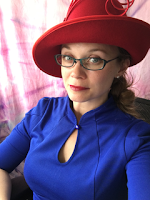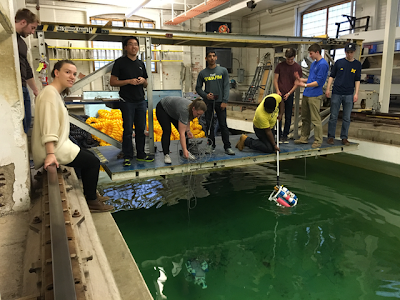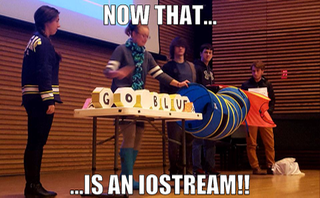Teaching
Fall 2019 Course
Engr 100-600 Course Description
This is a design-build-test-communicate course with a heavy emphasis on team-based, project-based, collaborative learning. That mouthful is a fancy way of saying: you will gain a lot of introductory-level engineering experience by building something interesting with a group of people!
Project
In our section, you will work in a team of five to design, build, test, and communicate about a remotely operated vehicle (ROV), sometimes called a submersible, for underwater exploration. The ROV has a set of tasks that it will need to do, but otherwise this is a “free design” project with minimal constraints on size, shape, and function. Your team will be provided with raw building materials, four thrusters, a blank control box, toggle switches and buttons, and a payload consisting of a battery, a video camera (to “see what the ROV sees” and help complete the set of tasks), and a tether to a float. The float connects wirelessly to a control box that you will design and build. You will have an opportunity to test your ROV in the towing tank at the Marine Hydrodynamics Laboratory (MHL) in West Hall. An ROV competition is held on a weekend near the end of the semester at the MHL. At the competition, your team will present its ROV design to our industry sponsor and then conduct final ROV testing in the MHL’s towing tank. A written progress report and a final report are also deliverables for this project.
Lecture, Discussion, and Lab
This section has a lecture component, a discussion component, and a lab component. The lectures are a time when content is provided and/or practiced; they are highly group/team-oriented and taught in a “studio” style where you sit with your team or other small group. Discussions are a time when we provide and practice content that is more suitable to a smaller class size. Labs are when you will gain the hands-on build and test experience with your team. Throughout the course, collaboration is highly encouraged and required. To emphasize the importance of collaboration in Engr 100-600, course engagement points are assigned to many activities in lecture, discussion, and lab. If you miss a lot of class, you will not earn these points, and it will be difficult to do well in the course.
Your team will use a dedicated lab to construct and test your ROV during regular lab times and open lab times provided by the Instructional Assistants (IAs) for the class. Peer mentors -- students who have previously taken this course -- are assigned to each team to provide design guidance and offer support.
Course Content and Workload
The goal of Engr 100-600 is to provide an opportunity for you to gain experience in a wide range of engineering skills. Before you get super excited that you are going to become an expert hydrodynamicist after a single introductory engineering course, we want to remind you that this is an intro course. And it’s an intro course that is focused on communication and hands-on learning in a general engineering sense. We don’t have the time to go deep into any technical content. However, we will touch on the following engineering topics within the context of the ROV project: team communication and collaboration, 3D modeling and printing, pressure, buoyancy, stability, technical documentation (presentations and reports), basic electric circuits, systems design, probability, statistics, risk, and ethics.
Fair warning: Past students generally report that the workload for Engr 100-600 is higher than other sections of Engr 100 but that the extra work is worth it. More than one of our past students has said that they owe a summer internship after their first year in college to the experience they could list after taking Engr 100-600.
Should you Take this Course?
This course will likely be of greatest interest to those students looking to major in naval architecture & marine engineering, but any student who is interested in a rewarding, hands-on introduction to engineering at U-M is very welcome. We’ve worked hard to create a multi-disciplinary project that will appeal to a wide range of students, so hopefully everyone will find something interesting to do!
If you are hoping to register for this section in the fall term but find that it is already full, please email the First-Year Programs Coordinator, Krista Quinn, at engin-fyp-at-umich.edu to request your name be added to a list for winter term.
Philosophy
I try to emulate all the best teachers I've ever had, and I try to do the opposite of all the bad teachers I've ever had! Mostly, though, I try to remember that my students are people, too, and we all have lives outside of class. I try not to overload them with work just for my class, and I hope that they remember that I'm not continually hanging out online waiting to immediately respond to a question they post. I encourage empathy in my students and myself and consider humor a valuable teaching tool.

Current Courses
Engr 100: Intro to Engineering, Underwater Vehicle Design
This is an intensive first-year course for engineering students that covers engineering design and technical communication. All first-year engineering students are required to take this class. There are many sections to choose from, each with its own flavor. Mine, as you might image, has a naval architecture and marine engineering flavor. I am the technical instructor for Section 600, in which students work in teams of five to build Remotely Operated Vehicles over the course of the semester as part of a design-build-test-communicate cycle. You will not become an expert hydrodynamicist in Engr 100-600. However, you will get exposure to the following engineering topics within the context of the ROV project: team communication and collaboration, 3D modeling and printing, pressure, buoyancy, stability, technical documentation (presentations and reports), basic electric circuits, systems design, probability, statistics, risk, and ethics. Whew! Thank goodness I have excellent co-instructors and teaching assistants!
If you are a current U-M student who is trying to figure out what section of Engr 100 to take, here is a more detailed course description for Section 600 that might help you in your decision-making.

Engr 101: Intro to Computer Programming
Okay, so this is another course that first-year engineering students are required to take. But this one is run a little differently than Engr 100. Engr 101 is run as one giant course, with about 700 students a semester, broken into 3 lectures, one of which I teach. But don't worry! We have a huge team of fantastic graduate and undergraduate instructors to help us; they are from all the different engineering departments and they are eager to help you learn to harness your most powerful engineering tool: your computer. We focus on solving real-world engineering problems using computer programming to automate our calculations and display our data so we can make informed decisions. There are 6 projects that will guide you through solving engineering problems using computer programming such as error analysis, system coefficient selection, health monitoring, and delivery logistics. If you have experience with programming already, each project has a number of "reach goals" to keep you honing those programming skills. No matter what your skill level is, come hang out with us during office hours and see how truly powerful your computer can be with you at the helm (yeah, had to work in a naval arch reference there). I promise, I'll bring fruit snacks for when we're ready to pull out our hair because we can't find that one bug.

Past Courses
Hydrostatics Short Course, Naval Engineering Education Center (NEEC)
I created a series of short video lectures on basic hydrostatics concepts for the Naval Engineering Education Center (NEEC). These videos are aimed at familiarizing new Navy hires whom do not have prior ship experience with some basic ship terminology and concepts in how to keep your ship from sinking. Watch the videos here. I can't believe I'm on YouTube. (Well, in an official capacity, at least. It's not like the bar is very high for entry to YouTube.)